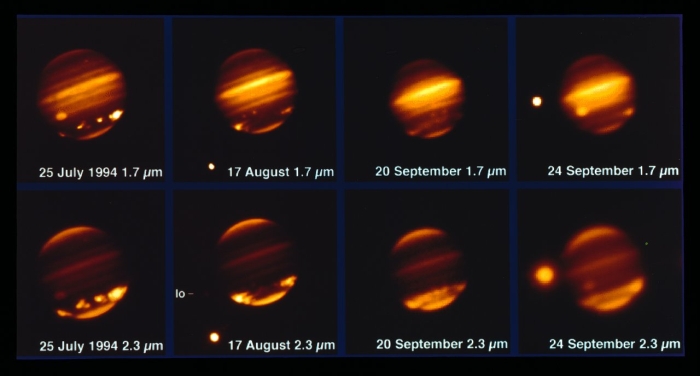It collided with Jupiter in 1994, but Comet Shoemaker-Levy 9 still apparently has things to teach us about the Solar System's largest planet.
A new analysis of the traces of the comet's impact – still zooming around Jupiter's atmosphere – has yielded the first direct measurement of the gas giant's powerful stratospheric winds, in the cloudless middle layer of the atmosphere.
There, narrow bands of wind known as jets – like Earth's jet streams – blow at up to 400 meters per second at high latitudes. That's around 1,440 kilometers per hour (895 mph) – vastly outstripping the top wind speeds of around 620 km/h seen in the Great Red Spot cyclonal storm.
The team's detection and analysis suggest that these jets could act like a colossal vortex, about 50,000 kilometers in diameter and 900 kilometers high.
"A vortex of this size," said astronomer Thibault Cavalié of the Laboratoire d'Astrophysique de Bordeaux in France, "would be a unique meteorological beast in our Solar System."
The death of Comet Shoemaker-Levy 9 was one of the most spectacular events we've ever seen in the Solar System. First, as the icy rock veered close to Jupiter, it was torn apart by the immense gravitational pull of the planet.
The fragments spent two Earth years in closer and closer orbit, until finally, in July 1994, they collided with Jupiter's atmosphere in a riveting display of fireworks.
 The 1994 impact of Shoemaker-Levy 9. (ESO)
The 1994 impact of Shoemaker-Levy 9. (ESO)
For scientists, it was an incredible gift. The impact churned up Jupiter's atmosphere, revealing new molecules and scarring Jupiter's surface for months. This allowed measurements of wind speed and new studies of the atmospheric composition of Jupiter, as well as its magnetic field.
The comet impact also added new molecules that weren't already present on Jupiter. These included ammonia – which disappeared within a few months – and hydrogen cyanide, which can still be detected in the Jovian stratosphere to this day.
It was this hydrogen cyanide that a team of scientists tracked using 42 of the 66 antennas of the Atacama Large Millimeter/Submillimeter Array in Chile. Using this powerful instrument, astronomers observed the Doppler shift of the hydrogen cyanide – the way the wavelength of the molecule's electromagnetic emission lengthens or shortens depending on whether it's moving away from or towards the observer.
"By measuring this shift, we were able to deduce the speed of the winds much like one could deduce the speed of a passing train by the change in the frequency of the train whistle," said planetary scientist Vincent Hue of the Southwest Research Institute in the US.
Analyzing the length of these shifts allows scientists to calculate the speed at which the hydrogen cyanide is moving.
Around the equator of the planet, strong stratospheric wind jets blow at average speeds of around 600 kilometers per hour. All the time. Here on Earth, the maximum wind speed ever recorded was 407 km/h (253 mph), and that was during a wild tropical cyclone.
One of the most intriguing jets, though, was found directly below Jupiter's permanent auroral oval, several hundreds of kilometers below the auroral winds. It was clockwise in the north and anti-clockwise in the south, at speeds of up to 300 to 400 meters per second. The team thinks that this jet is the lower tail of the auroral wind.
Previous studies had predicted that the auroral winds would decrease in strength as altitude decreased, dissipating before reaching the stratosphere, so this was a surprise – a beautiful demonstration of the unseen atmospheric complexity in a planet we already knew was insanely atmospherically complex.
And it sets the stage for future observations from upcoming missions, such as the European Space Agency's JUpiter ICy moons Explorer (JUICE) probe, and the terrestrial Extremely Large Telescope currently under construction.
"These ALMA results open a new window for the study of Jupiter's auroral regions," Cavalié said.
The research has been published in Astronomy & Astrophysics.
#Space | https://sciencespies.com/space/echoes-from-a-comet-that-crashed-in-1994-have-revealed-new-data-on-jupiter/
No comments:
Post a Comment